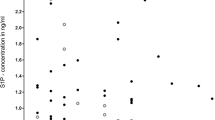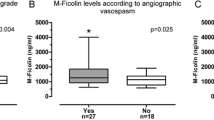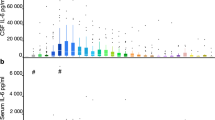Summary
Lipid peroxidation and enhanced arachidonic acid metabolism is activated after blood-brain cell contact. Previous studies have indicated that cysteinyl-leukotrienes (cys-LT) have the capacity to constrict arterial vessels in vivo and in vitro suggesting their involvement in the pathogenesis of cerebral vasospasm. The purpose of this study was to measure the amount of cyst-LT in the cerebro-spinal fluid (CSF) in correlation with transcranial Doppler findings (TCD) in patients with aneurysmal subarachnoid haemorrhage (SAH). In all patients early surgery was performed. In the first cisternal CSF-sample which was already collected intra-operatively an initial peak of cys-LT was detected, followed by decreasing amounts of cys-LT during the next 5 days. The CSF-levels of immunoreactive cys-LT were significantly higher in those patients who showed signs of vasospasm on transcranial Doppler sonography (TCD) (p < 0.001). Normalization of TCD values was accompanied by decreasing levels of CSF-cys-LT. We found a significant correlation between the amounts of immunoreactive cys-LT in cerebrospinal fluid and cerebral vasospasm measured by TCD.
Similar content being viewed by others
References
Asano T, Watanabe T, Takakura K, Sano K, Shimizu T (1988) Activation of the lipoxygenase pathway following subarachnoid hemorrhage: its relevance to cerebral vasospasm. In: Wilkins RH (ed) Cerebral vasospasm. Raven, New York, pp 297–302
Chan PH, Fishman RA, Caronna J (1983) Induction of brain edema following intracerebral injection of arachidonic acid. Ann Neurol 13: 625–633
Dempsey RJ, Roy MW, Cowen DE (1986) Lipoxygenase metabolites of arachidonic acid and the development of ischaemic cerebral oedema. Neurol Res 8: 53–56
Findlay JM, Macdonald RL, Weir BKA (1991) Current concepts of pathophysiology and management of cerebral vasospasm following aneurysmal subarachnoid hemorrhage. Cerebrovasc Brain Metab Rev 3: 336–361
Fisher CM, Kistler JP, Davis JM (1980) Relation of cerebral vasospasm to subarachnoid hemorrhage visualized by computerized tomography scanning. Neurosurgery 6: 1–9
Gaetani P, Marzatico F, Rodriguez Y, Baena R (1992) Ex vivo release of eicosanoids after aneurysmal subarachnoid hemorrhage: a preliminary experience in humans. Acta Neurol Scand 86: 184–189
Hagen AA, White RP, Robertson JT (1979) Synthesis of prostaglandins and thromboxane B2 by cerebral arteries. Stroke 10: 306–309
Harders A (1986) Neurosurgical applications of transcranial Doppler sonography. Springer, Wien New York
Hubschmann OR, Nathanson DC (1985) The role of calcium and cellular membrane dysfunction in experimental trauma and subarachnoid hemorrhage. J Neurosurg 62: 698–703
Hunt WE, Hess RM (1968) Surgical risk as related to time of intervention in the repair of intracranial aneurysm. J Neurosurg 28: 14–20
Kassell NF, Sasaki T, Colohan ART, Nazar G (1985) Cerebral vasospasm following aneurysmal subarachnoid hemorrhage. Stroke 16: 562–572
Kiwak KJ, Moskowitz MA, Levine L (1985) Leukotriene production in gerbil brain after ischemic insult, subarachnoid hemorrhage, and concussive injury. J Neurosurg 62: 865–869
Kobayashi H, Ide H, Handa Y, Aradachi H, Arai Y, Kubota T (1992) Effect of leukotriene antagonist on experimental delayed cerebral vasospasm. Neurosurgery 31: 550–556
Kontos HA, Wei EP, Ellis EF (1981) Prostaglandins in physiological and in certain pathological responses of the cerebral circulation. Fed Proc 40: 2326–2330
Leslie JB, Wilkins WD (1985) Eicosanoids in the central nervous system. J Neurosurg 63: 659–668
Moskowitz MA, Kiwak KJ, Hekimian K, Levine L (1984) Synthesis of compounds with properties of leukotrienes C4 and D4 in gerbil brains after ischemia and reperfusion. Science 224: 886–889
Piper PJ, Samhoun MN (1987) Leukotrienes. Br Med Bull 43: 297–311
Paoletti P, Gaetani P, Grignani G, Pacchiarini L, Silvani V, Rodriguez Y, Baena R (1988) CSF leukotriene following sub-arachnoid hemorrhage. J Neurosurg 69: 488–493
Rosenblum WI (1985) Constricting effect of leukotrienes on cerebral arterioles of mice. Stroke 16: 262–263
Samuelsson B, Dahlen SE, Lindgren JA, Rouzer CA, Serhan CN (1987) Leukotrienes and lipoxins: structures, biosynthesis and biological effects. Science 237: 1171–1176
Schweitzer P, Madamba S, Siggins GR (1990) Arachidonic acid metabolites as mediators of somastatin-induced increase of neuronal M-current. Nature 346: 464–467
Siesjö BK, Wieloch T (1983) Prostaglandins and the cerebral circulation. Adv Prost Thrombox Leuk Res 12: 339–344
Shimizu T, Watanabe T, Asano T, Seyama Y, Takakura K (1988) Activation of the arachidonate 5-lipoxygenase pathway in the canine basilar artery after experimental subarachnoid hemorrhage. J Neurochem 51: 1126–1131
Simmet T, Seregi A, Herting G (1987) Formation of sulphido-peptide-leukotrienes by tissue of spontaneously convulsing gerbils. Neuropharmacology 26: 107–110
Simmet T, Luck W, Winking M, Delank WK, Peskar BA (1990) Identification and characterization of cysteinyl-leuko-triene formation in tissue slices from human intracranial tumors: evidence for their biosynthesis under in vivo conditions. J Neurochem 54: 209–2099
Simmet T, Peskar BA (1990) Lipoxygenase products of poly-unsaturated fatty acid metabolism in the central nervous system: biosynthesis and putative functions. Pharmacol Res 22: 667–682
Tagari P, du Boulay GH, Aitken V (1983) Leukotriene D4 and the cerebral vasculature in vivo and in vitro. Prostaglandins Leukot Med 11: 281–297
Watanabe T, Asano T, Shimizu T, Seyama Y, Takakura K (1988) Participation of lipoxygenase products from arachidonic acid in the pathogenesis of cerebral vasospasm. J Neurochem 50: 1145–1150
Weir B, Grace M, Hansen J, Rothberg C (1978) Time course of vasospasm in man. J Neurosurg 48(2): 173–178
Winking M, Lausberg G, Simmet T (1992) Malignancy dependent formation of cysteinyl-leukotrienes in human brain tumor tissues and its detection in urine. In: Piscol K, Brock M, Klinger M (eds) Advances in neurosurgery, Vol 20. Springer, Berlin Heidelberg New York Tokyo
Winking M, Boeker DK, Simmet T (1995) Blood-brain cell contact triggers leukotriene formation in brain cells via thrombin. J Cereb Blood Flow Metab 15 [Suppl 1]: 700
Winking M, Heldt RM, Simmet T (1996) Thrombin is the stimulus liable for activation of the cerebral 5-lipoxygenase pathway during blood-brain cell contact. J Cereb Blood Flow Metab 16: 737–745
Yokota M, Tani E, Maeda Y (1987) Effect of 5-lipoxygenase inhibitor on experimental delayed cerebral vasospasm. Stroke 18: 512–518
Author information
Authors and Affiliations
Rights and permissions
About this article
Cite this article
Winking, M., Müller, H.W., Deinsberger, W. et al. Levels of immunoreactive cysteinyl-leukotrienes in CSF after subarachnoid haemorrhage correlate with blood flow-velocity in TCD. Acta neurochir 139, 764–769 (1997). https://doi.org/10.1007/BF01420051
Issue Date:
DOI: https://doi.org/10.1007/BF01420051




